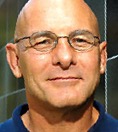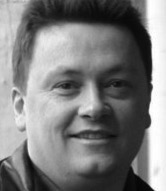RAID Is 30-Year Old
Invented by David Patterson, Garth A. Gibson and Randy Katz at University of California, Berkeley in 1987
By Jean Jacques Maleval | November 20, 2017 at 2:46 pmThe term RAID was invented by David Patterson, Garth A. Gibson and Randy Katz at the University of California, Berkeley, CA in 1987.
In June 1988 they presented a paper A Case for Redundant Arrays of Inexpensive Disks (RAID) at the SIGMOD conference.
It advocated that we should be replacing big disks by lots of small disks using RAID technology. RAID-5 was the most interesting invention used by about all disk arrays to protect data on HDDs and now on SSDs.

The concept of redundancy for data protection was introduced and proposed the fundamental approach to data protection that remains the industry standard today.
The Berkeley RAID paper detailed the path the storage industry would follow to increase the performance and reliability of storage systems, thereby enabling storage to keep pace with continuing advancements in central processing unit and system memory performance in accordance with Moore’s Law. The redundancy concept introduced by the paper included RAID levels one through five, providing the industry a comprehensive framework with which to tailor the balance of reliability, availability, performance and capacity to individual storage deployments and workloads.
The paper and its authors have earned a host of industry accolades, including the IEEE Reynold B. Johnson Information Storage Systems Awards (1999), the ACM SIGMOD Test of Time Award (1999), the SIGOPS Hall of Fame Award (2011) and the 2012 Jean-Claude Laprie Award in Dependable Computing.
First RAID levels used were 1, 3, and 5.
Since then RAID-6 appears with one more parity disk, 10 and also defuncts 7 et S. Raidix offers 7.3 with triple parity.
Although not yet the term RAID, the technologies of the five levels of RAID were used in various products prior to the Berkeley paper’s publication, including:
- Mirroring (RAID-1) was well established in the 1970s including for example Tandem NonStop Systems.
- In 1977, Norman Ken Ouchi at IBM filed a patent disclosing what was subsequently named RAID-4.
- Around 1983, DEC began shipping subsystem mirrored RA8X disk drives (now known as RAID-1) as part of its HSC50 subsystem.
- In 1986, Clark et al. at IBM filed a patent disclosing what was subsequently named RAID-5.
- Around 1988, the Thinking Machines’ DataVault used error correction codes (now known as RAID-2) in an array of disk drives. A similar approach was used in the early 1960s on the IBM 353.
At the beginning it was essentially hardware RAID. Software RAID implementations were then provided by many OSs.
More recent idea to have multiple copies of data on several nodes in a network will limit the use of RAID technology.
Profile of inventors
David A. Patterson
 He has been chair of the CS Division in the EECS department at Berkeley, the ACM Special Interest Group in Computer Architecture (SIGARCH), and the Computing Research Association (CRA). He was also elected President of ACM for 2004 to 2006. He was a member of the National Academy of Sciences Computer Science and Telecommunications Board and the CRA Board. He has consulted for several companies, including Digital (now HP), Hewlett Packard, Intel, Microsoft, and Sun Microsystems, and is on the technical advisory board of several companies. He currently is vice chairman of the board of directors of the RISC-V Foundation.
He has been chair of the CS Division in the EECS department at Berkeley, the ACM Special Interest Group in Computer Architecture (SIGARCH), and the Computing Research Association (CRA). He was also elected President of ACM for 2004 to 2006. He was a member of the National Academy of Sciences Computer Science and Telecommunications Board and the CRA Board. He has consulted for several companies, including Digital (now HP), Hewlett Packard, Intel, Microsoft, and Sun Microsystems, and is on the technical advisory board of several companies. He currently is vice chairman of the board of directors of the RISC-V Foundation.
Garth A. Gibson
 He is Professor and Assoc. Dean, Computer Science, CMU, and and president and CEO, Vector Institute, effective Jan 2, 2018. He was at Panasas that he co-founded for 13 years, starting as CTO from 1999 to 2012 and then chief scientist from 2012 to 2016.
He is Professor and Assoc. Dean, Computer Science, CMU, and and president and CEO, Vector Institute, effective Jan 2, 2018. He was at Panasas that he co-founded for 13 years, starting as CTO from 1999 to 2012 and then chief scientist from 2012 to 2016.
Randy Howard Katz
 He is a distinguished professor at University of California, Berkeley of the electrical engineering and computer science department. He received an A.B. from Cornell University (May 1976), MS from UC Berkeley (June 1978), and Ph.D. from UC Berkeley (June 1980) all in computer science. He is a fellow of both the Association for Computing Machinery (ACM) and Institute of Electrical and Electronics Engineers (IEEE), and a member of National Academy of Engineering and the American Academy of Arts and Sciences. He has published over 250 refereed technical papers, book chapters, and books.
He is a distinguished professor at University of California, Berkeley of the electrical engineering and computer science department. He received an A.B. from Cornell University (May 1976), MS from UC Berkeley (June 1978), and Ph.D. from UC Berkeley (June 1980) all in computer science. He is a fellow of both the Association for Computing Machinery (ACM) and Institute of Electrical and Electronics Engineers (IEEE), and a member of National Academy of Engineering and the American Academy of Arts and Sciences. He has published over 250 refereed technical papers, book chapters, and books.














 Subscribe to our free daily newsletter
Subscribe to our free daily newsletter


